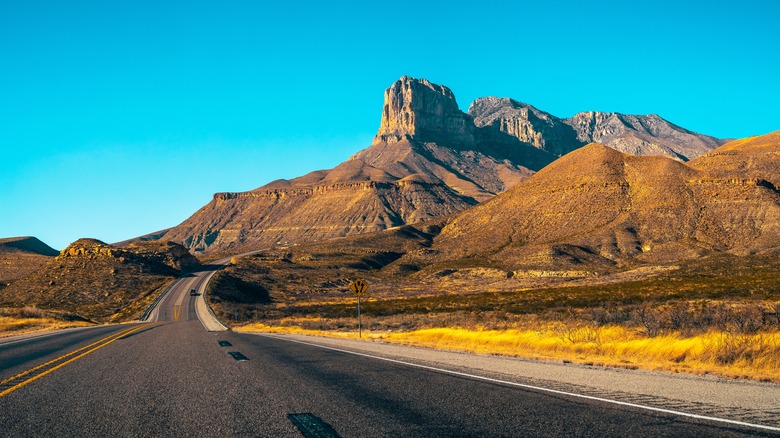The Texas National Park That's Known For Its Incredibly Treacherous Trail
Want to stand on the "Top of Texas"? In Guadalupe Mountains National Park, you can, but getting there won't be easy. Home to the four highest peaks in Texas, the park is a playground for hikers with a thirst for adventure and endurance for testing treks.
If you're not familiar with many national parks, you may not have heard of this diamond in the deserts of West Texas. Guadalupe Mountains is one of the lesser visited national parks in the U.S.; it attracted just under 220,000 visitors in 2022. That's a small number compared to the almost 13 million who enjoyed Great Smoky Mountains National Park in North Carolina and Tennessee the same year. However, the lack of visitors is to its advantage, not its detriment. Visitors are surrounded by the solitude and majesty of nature, and there's no need to line up to take an Instagram photo on the mountaintops.
Sprawling across over 86,000 acres, the park is as diverse as it is vast. One moment, you're navigating arid desert plains peppered with prickly pear cacti; the next, you come across panoramas like the striking El Capitan limestone cliff. The ecosystem is equally varied, housing wildlife from bobcats and mountain lions to bull snakes and scorpions. Simply put, it's an outdoor lover's paradise with a southwestern twist. But behind these picturesque vistas lays a park renowned for its treacherous trails. Perhaps the most famous is the Guadalupe Peak trail, an 8.4-mile trek that takes you to the highest point in Texas.
Tread carefully on the Guadalupe Peak trail
With an elevation gain of 3,000 feet, the steep, rocky Guadalupe Peak trail will get your adrenaline pumping. The National Parks Service (NPS) has a ton of safety tips for completing the trail, including monitoring for dangerous thunderstorms and high winds, and carrying at least a gallon of water per person. Hikers reviewing the trek on AllTrails recommend starting as early as possible to avoid the heat; user Lauren Peedin set off at 2 a.m. The views, though, make the hike all worthwhile.
Other trails in the park may not climb as high as the Guadalupe Peak trail, but they are often just as spectacular. The challenging Devil's Hall trail earns a 4.6/5 rating on AllTrails and includes a scramble over boulders in the canyon and a climb up a stunning natural rock staircase. If you'd rather see the peaks but not scale them, try the Foothills Loop, which offers beautiful views of the El Capitan rock formation.
The beauty of the Guadalupe Mountains
Sure, the Guadalupe Peak trail can be intimidating. But the allure of the wild is often the promise of an adventure that pushes you out of your comfort zone. Besides, Guadalupe Mountains National Park is not all rough and tumble. There is endless flora and fauna to admire, as well as a fossilized reef that tells of the park's ancient history underwater. You can also dive into more recent history at the Frijole Ranch History Museum, where you can trace the human history of the park from the Native American inhabitants to early ranchers.
The sunrises and sunsets are breathtaking. If you start the Guadalupe Peak trail early enough, you'll get to see the sunrise from the top. And as night falls, the park comes alive in a different way, offering a glorious night sky for stargazing. And if you're staying to stargaze, you'll likely want to spend the night in one of the park's three simple but picturesque developed campgrounds.


